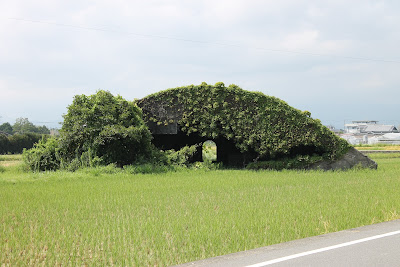WWII Relics Warn of the Dangers of War 第二次世界大戦の戦争遺跡が戦争の危機を語る
 |
| An airplane bunker used by the former Japanese Imperial Navy in WWII; photo by Justin Aukema, August 18, 2017 |
Justin Aukema
August 25, 2017
Every August there is a flurry of activity in Japan to commemorate the end of World War Two.
But with fewer members of the wartime generation alive it is getting harder to directly pass on memories of the war.
“Today the number of surviving members of the wartime generation (those over six years old at the time the war ended) in Japan has decreased to just 10% of the population,” says Yamanashi University professor Jūbishi Shunbu. “Without a doubt, memories of the war are moving from people to things.”[1]
Jūbushi is head of The Japanese Network to Preserve War Sites (Sensō iseki hozon zenkoku nettowāku; hereafter JNPWS), a group that formed in 1997 to preserve material heritages of the war.
A common example of a war site is the Hiroshima Peace Memorial (Genbaku Dome).
But by Jūbushi’s calculations, there are at least 50,000 other such sites around Japan. These include air-raid-damaged buildings and former military facilities. Many war sites have yet to be surveyed, researched, or preserved.[2]
The JNPWS wants to change that and to use war sites to teach future generations about the destruction of war and to ensure that war never happens again.
Every year since its founding the group has held symposiums bringing together war-site preservationists from around the country. Many participants are involved in movements to preserve war sites in their local communities.
This year, 300 people attended their 21st annual symposium in Kōchi City, Kōchi Prefecture from August 19th – 21st.
Like many places in Japan, important military facilities were built in Kōchi during the war including the Japanese Imperial Navy Kōchi Airfield – the site of the current Kōchi Ryōma Airport.
In January 1941, the Japanese Navy confiscated land from poor farmers to build the airfield. Eventually 3,686 soldiers and officers were using the site for aviation training. During the latter stages of the war, it was also a launching pad for Japanese Special Attack Unit (tokkōtai) “kamikaze” planes that were loaded with explosives and sent hurtling at U.S. ships.
 |
| One of the seven remaining airplane bunkers (entaigō) from the former Japanese Imperial Navy Kōchi Airfield; photo by Justin Aukema, August 18, 2017 |
Fujimoto Shinji (85) was just nine years old when he and other children from his nearby Iwamura Elementary School were mobilized to build airplane bunkers at the Navy airfield.
“I was a fourth-year elementary-school student when I was mobilized,” he explained as he led a group from the JNPWS on a tour of the site.[3]
“Since all the young men around twenty years old had been drafted and sent off to the battlefield, it was only us kids and elderly men and women left to do the work. There were also about 300 Korean forced laborers who had been taken from the Korean peninsula. Today this kind of work would be done with bulldozers and machines. But at that time, all we had was manpower, so we were forced to build with our bare hands,” Fujimoto continued.[4]
“The bunker that we’re in now was built over a farm road that was originally here and was used by the surrounding farmers as they tended their fields and farmed their crops. As you can see, there’s a small canal running alongside the road. This was very important for the farmers since it carried the water they used to irrigate their fields.”[5]
“But the Navy wanted to build the airplane bunker right over this. This meant that the villagers would not only lose access to their fields, but also that they wouldn’t be able to provide them with the necessary water for irrigation. They earnestly petitioned the Navy officers in charge to move the bunker just a little to either the left or the right so that it would be off the road and the canal. But at that time, questioning the military was an unpardonable offense. ‘What are you suggesting you traitors!’ the officers shouted at them. ‘Get the hell out of here!’ So they went back to their homes in tears and were unable to tend to their fields for the next three years.”[6]
“When the war ended, the villagers returned to this site, and they smashed in one of the walls of the bunker so that they could use the road that ran through it again,” Fujimoto said.[7]
Fujimoto’s story reflects the JNWPS’s vision for using war sites to pass on memories of the war.
They are keen to emphasize the contemporary significance of their efforts.
At the close of the 2017 Kōchi Symposium, the JNWPS issued an appeal that read: “The Japanese government passed security laws that allow for collective self-defense (shūdanteki jieken) and ‘conspiracy’ (kyōbōzai) legislation that limits citizens’ free speech. Moreover, the Abe administration is trying to ram through constitutional revision and meddle with Article 9.”
“In the context of once again trying to make Japan ‘a country that can wage war’ (sensō no dekiru kuni), our efforts to preserve and use war sites for peace and to pass on the truths of war to later generations can serve as a force to reverse these dangerous trends.”
Dehara Keizō, who organized the Kōchi JNWPS symposium and helps run a small, local peace museum called the Grass Roots House Peace Museum (Heiwa shiryōkan kusa no ie), emphasized the value of preserving war sites.
 |
| Dehara Keizō, who organized the 2017 JNPWS Kōchi Symposium, stands next to a small peace-resource center that he and other volunteers help run; photo Justin Aukema, August 21, 2017. |
“In a perfect world, we wouldn’t need to preserve war sites, since there would already be peace.”[8]
“But, unfortunately, the exact opposite is the case, and Japan is now moving closer to war.”[9]
“In this situation, we need to preserve as many of these sites as possible to show the dangers of past war and to educate about the importance of peace.”[10]
[1] Jūbishi, Shunbu. “Kichō hōkoku: Nihon no sensō iseki no
chōsa kenkyū to hozon 2017,” Dai 21 kai sensō iseki hozon zenkoku shinpojiumu
Kōchi taikai, August 20, 2017.
[2] Ibid., p. 6
[3] Interview with Fujimoto Shinji. Interview by Justin Aukema,
August 21, 2017.
[4] Ibid.
[5] Ibid.
[6] Ibid.
[7] Ibid.
[8] Interview with Dehara Keizō. Interview by Justin Aukema,
August 21, 2017.
[9] Ibid.
[10] Ibid.


